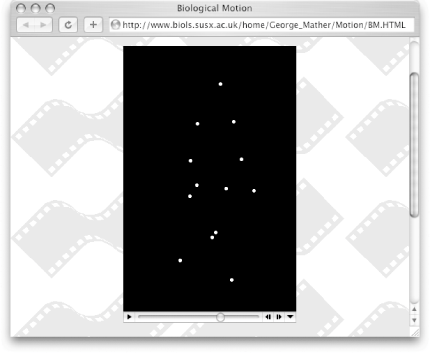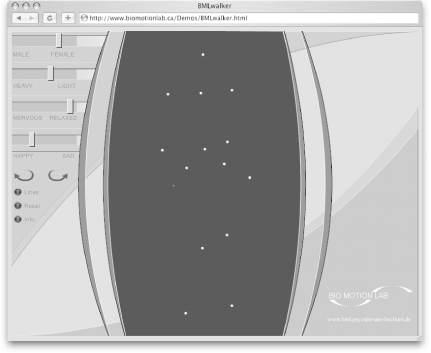Hack77.See a Person in Moving Lights
|
Hack 77. See a Person in Moving Lights
Lights on the joints of a walking person are enough to give a vivid impression of the person, carrying information on mood, gender, and other detailsbut only while the person keeps moving. Visual perception has special routines for grouping things that move along together into single objects [Hack #76] . That's why we see cars as cars and not a collection of wheels, glass, and side-view mirrors just happening to travel along in the same direction. That's all well and good, but humans live not just in a world of objects like trees and cars, but a world full of people. Given how social we are, and how tricky other people can be, it's not surprising we also have specialized routines for grouping things that move like people together into single objects too. Looking at only a constellation of moving points of light attached to knees, elbows, and other parts of the body, we a get vivid perception of a person, a perception that doesn't exist at all when the points of light are still. 8.4.1. In ActionOpen up your browser and point it at http://www.lifesci.sussex.ac.uk/home/George_Mather/Motion/BM.HTML1 or http://www.at-bristol.org.uk/Optical/DancingLights_main.htm (both are QuickTime movies). What do you see? Both are just points of light moving in two dimensions. Yet the first is clearly a person walking, and the second obviously two people dancing, fighting, and otherwise performing. As with the common fate demos [Hack #76] of how we group objects by their behavior over time, you can remove the effect by pausing the movies. This information only makes sense when it is moving (shame we can't have animations in the book, really), which is why Figure 8-4 (a frame of the first movie) looks more like a random star constellation than a human figure. Figure 8-4. If this were moving, it'd look like a person walking The vivid impression of a walking human shows that we are able to integrate the correlations of the light points and match them to some kind of template we have developed for moving humans. It is orientation-specific, by the way. Watch the video upside down (it's easier if you have a laptop), and you won't see anything resembling human motion at all. And we don't perceive just abstract form from the moving lights. The demo at http://www.bml.psy.ruhr-uni-bochum.de/Demos/BMLwalker.html, shown in Figure 8-5, allows you to vary the gender, direction, weight, mood, and energy levels of the walker using the sliders on the left. Figure 8-5. A happy heavyset man, as represented by points of light You can tell if the moving lights are from a heavyset man who's happy or if they are from a medium-build woman who is slightly afraid. All just from way the lights move. 8.4.2. How It WorksThe effect is obvious. That we can perceive the human formeven mood and genderjust from moving lights demonstrates that we automatically extract underlying patterns from the normal human forms we see every day. Through a combination of experience and specialized neural modules, we have learned the underlying commonalities of moving human formsthe relationships in time and space between the important features (the joints) of the human body. Our brain can then use this template to facilitate recognition of new examples of moving bodies. Being able to do this provides (for free) the ability to perceive a whole just from abstracted parts that move in the right way. A similar process underlies the perception of expressions in emoticons [Hack #93] . It's the reason cartoonists and caricaturists can make a livingshowing just the essentials is as expressive, maybe even more expressive, than the full image with all its irrelevant details.
Perceiving biological motion from moving lights isn't something that falls out of other, normal, visual processes.2 Brain imaging studies show that the process involves various brain regions, not only those normally involved with vision are brought to bear, but also those involved in object memory, spatial processing, and even motor processes.3,4 Even better, when the lights give the impression of a fearful person, the part of the brain (the amygdala) that normally responds to fearful expressions on faces is evoked.5 Our specialized mechanisms for recognizing biological motion link direct to our emotions. The algorithm for perceiving biological motion doesn't always get it right. A light-point walker can actually appear to move in two directions at once. True light-point walkers are based on real people, and you can tell which direction they're walking in. The "chimeric walker" QuickTime movies (http://www.kyb.tuebingen.mpg.de/bu/demo/chimericwalker) have been edited to superimpose two walkers moving in opposite directions, one to the left and one to the right. Your biological motion detection kicks in, and you see a person moving, as normal, but you're really looking at only one set of the superimposed dotswith a little effort you can see the person going the other way instead. With a little more effort you can flip between seeing the two walkers, voluntarily. The detection algorithm's been fooled; you would never see this particular moving dot configuration in the wild.6 8.4.3. In Real LifeIf you are a cyclist, you can use our specialized adaptation to the perception of biological motion to your advantage. Fluorescent safety markings that are positioned to tap into this biological motion detection system, by being placed on the joints, have been shown to make you more conspicuous to motorists.7 8.4.4. End Notes
|
|
EAN: N/A
Pages: 159